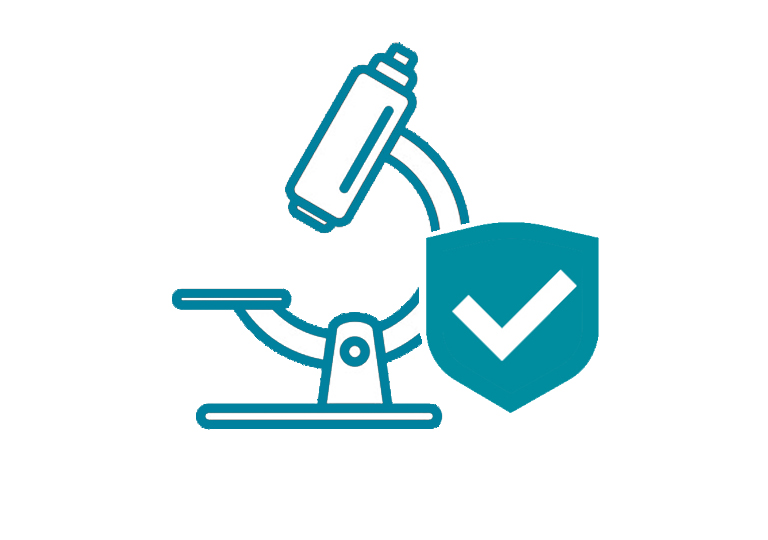Quality control

 Quality control (QC) has been defined as an essential aspect of research involving the use of cultured cells by both the Guidance on good cell culture practice. a report of the second ECVAM task force on good cell culture practice - PubMed and Guidelines for the use of cell lines in biomedical research - PubMed. Both sets of guidelines outline the importance of ensuring that cell lines are free from contamination and that they are of the correct identity. The ECACC QC team offers a suite of contamination testing services for cell cultures that are accredited by UKAS to ISO 17025:2017 and provide authentication services that can be found here.
Quality control (QC) has been defined as an essential aspect of research involving the use of cultured cells by both the Guidance on good cell culture practice. a report of the second ECVAM task force on good cell culture practice - PubMed and Guidelines for the use of cell lines in biomedical research - PubMed. Both sets of guidelines outline the importance of ensuring that cell lines are free from contamination and that they are of the correct identity. The ECACC QC team offers a suite of contamination testing services for cell cultures that are accredited by UKAS to ISO 17025:2017 and provide authentication services that can be found here.
Sterility testing - Bacteria and Fungi

Our sterility test method is based on the Bacteria and Fungi testing by culture method from the FDA Code of Federal Regulations. Title 21 (610.12). The cell line under test is used to inoculate Fluid Thioglycolate Medium (FTM) and Tryptone Soya Broth (TSB) and incubated for 14 days. Fluid thioglycollate medium is used for the detection of anaerobic bacteria, although aerobic bacteria may also proliferate in this medium. TSB will support the growth of fungi and aerobic bacteria.
Sterility Testing – Mycoplasma

Mycoplasma covering the surface of a single Vero cell in culture
Mycoplasma are the smallest free-living microorganisms, they cannot be seen using phase contrast microscopy or enriched in the standard sterility test method detailed above. They are common contaminants of cell cultures (Mycoplasma contamination of cell cultures: Incidence, sources, effects, detection, elimination, prevention - PubMed.) and effects of mycoplasma contamination on cell lines can include:
-
alteration of growth rate
-
induction of morphological changes
-
chromosomal aberrations
-
altered cell metabolism
-
decreased viability upon resuscitation of frozen ampoule.
-
induction of transformation, apoptosis, cytokines, signal transduction and oxidative radicals
-
macrophage activation
-
inhibition of antigen presentation
Find out more about Mycoplasma testing here.
Steps for Sample Submission
1. Complete the sample submission form here and the Biohazard Risk Assessment - Cell Lines form for whole cell samples or the Biohazard Risk Assessment form – Nucleic Acids if sending extracted DNA and e-mail the forms and a Purchase Order (PO) to CultureCollections@ukhsa.gov.uk.
2. You will receive a reference number from our service desk for correspondence regarding your order.
Not an existing customer? - Set up an account here.
3. The QC team will review the biohazard risk assessment form to ensure we can safely accept your samples. Please note that for some Genetically Modified Microorganism (GMM) samples there may be a delay as we assess against our internal GMM procedures. Any delay and timeframes will be communicated via the service desk.
4. The QC team will respond via the service desk when the review is complete and if your samples can be accepted.
5. Send your samples as per the Sample Preparation and Shipping section below to:
01/200 QC Testing Department,
Culture Collections,
UK Health Security Agency,
Porton Down,
Salisbury,
SP4 0JG, UK
Notification of dispatch of samples to ECACC is very much appreciated.
Testing is initiated on Tuesdays and Fridays and takes two weeks for a qPCR or Indirect Hoechst result, 4 weeks for a Bacteria and Fungi Sterility test and 6 weeks for Culture Isolation for growing samples. For frozen samples the time taken to resuscitate the cell line varies depending on the growth rate of the line and will add to the time from sample receipt to result reporting
6. Preliminary results will be reported via the service desk as soon as they are available. The final result will be reported via Certificate of Analysis following review by our Quality Assurance department.
Sample Preparation and Shipping
If sending growing cultures:
-
Growing cultures should have been passaged twice in the absence of antibiotics. They should have been growing for three days since the last medium change. ECACC need to be notified of the time of the last medium change so that, if necessary, the minimum growth time in the absence of antibiotics can be completed at ECACC
-
Growing cultures should be sent in flasks topped up with medium. The flask cap should be of the non-vented variety and wrapped e.g. in parafilm, to prevent leakage. The flask should then be packed in a leak proof bag or primary container with adequate absorbent material to contain the contents of the flask if there is any breakage or leak
If sending frozen cultures:
-
A handling fee will be charged to cover costs of establishing the cell lines in culture
-
Details of the cell line growth media and culture conditions must be supplied with the Sample Submission form.
Price of testing
|
Name of test |
Quality Control |
Catalogue number |
Price |
|---|---|---|---|
|
Bacteria and fungi testing by culture |
Sterility testing |
ECSR04 |
£118.45 |
|
Mycoplasma Detection by qPCR |
Mycoplasma testing |
ECSR33 |
£125 |
|
Mycoplasma Detection by Indirect Hoechst Stain |
Mycoplasma testing |
ECSR60 |
£125 |
|
Mycoplasma Detection by Culture Isolation |
Mycoplasma testing |
ECSR61 |
£175 |
|
Sample preparation from frozen ampoule |
Mycoplasma testing |
ECSR30 |
£75 |
